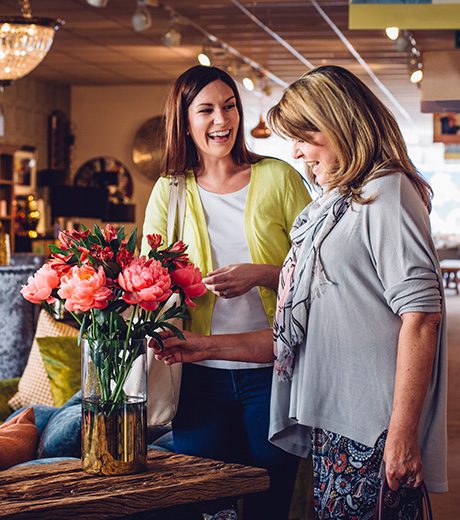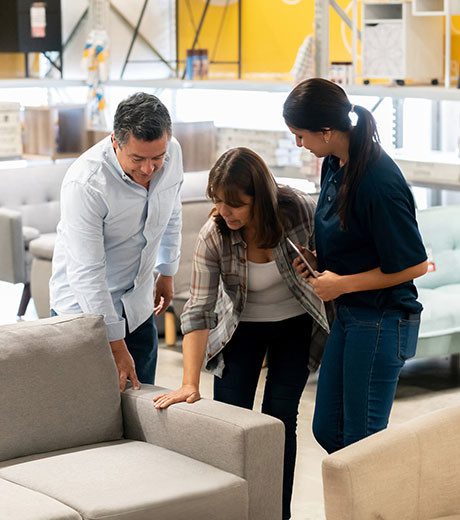Over the last several years, the home goods sector of retail has grown and developed, changing the way consumers shop for furniture. Retail giants Walmart and Target have expanded their offerings, and technology, through various partnerships or private label lines — both in store and online. And Amazon added three furniture brands to its list of private labels offering home decor in the last two years — Rivet, Stone & Beam and, most recently, Ravenna Home.
The expansions are for good reason, too. Between 2013 and 2018, the home goods markets in brick-and-mortar and e-commerce grew 20.9 percent and 88.7 percent, respectively, according to Euromonitor.
As the space increasingly becomes more crowded, independent furniture retailers are looking for ways to stand out to consumers. Augmented and virtual reality integration are two important ways. Still, the new technology won’t necessarily solve problems plaguing home goods retailers. Here are the trends taking shape in the space and how retailers are reacting.
AR and VR gain popularity
While mixed reality technology itself isn’t new, the implementation of it as part of the path to purchase has gained traction.
Perhaps the greatest benefit of the technology is for brands and retailers that play entirely online, where customers have little to no opportunity to try a product before purchasing. One popular application of AR and VR is as a tool to help customers better visualize pieces in their home. Wayfair and Overstock both added AR capabilities to their Android mobile apps a year ago.
However, there are still questions about whether the addition of these technologies is impacting consumer shopping behavior. It might be, and what retailers are currently offering is likely just the beginning of AR technology, according to RetailNext Marketing Director Ray Hartjen.
“It’s not so much the product that’s disrupting furniture in the marketplace, it’s the way shoppers are shopping that’s disrupting the marketplace,” Hartjen said. “The technology is there already, it just needs to be developed out.”
While current technology allows consumers to test what pieces of furniture will look like in their homes, Hartjen predicts virtual showrooms within the home will be the next step. If a customer isn’t satisfied with the look of an item, offering consumers the option to enter “a virtual store and (be) able to walk around and pick some items up,” may fill that void, he said.
Physical stores in a digital age
As the number of digitally native brands in the home goods space grows, many have taken notes from the success of Warby Parker and Casper, recognizing the benefits of giving consumers the opportunity to interact with their products through brick-and-mortar locations. However, these brands still don’t hold a candle to the legacy national and regional stores.
Retailers need to understand that it can’t be either online or physical, Hartjen said, but must be a partnership. “It’s not a question of being a digital brand or a physical brand, but it’s a combination of the two,” he said.
The way that traditional home goods retailers operate — very large stores with inventory arranged sporadically — is quickly becoming outdated, said Hartjen. “Undoubtedly, there’s too big stores, there’s too many big stores, and because of that, they have a swollen supply chain, bloated inventories, and the impact of that in a super-competitive environment is crippling effects of cash flow … you just have all this money tied up in inventory that’s killing the balance sheet.”
While Hartjen thinks the best plan for retailers in the sector is to shrink their square footage and magnify the design factor for more of a showroom feel, stores serve a different purpose for a big regional chain. These stores lean on the larger-sized format because they often double as warehouse spaces for the retailers, according to Hart Posen, associate professor of management at the University of Wisconsin-Madison. Before Casper and others disrupted the mattress industry by figuring out how to box mattresses and ship them easily across the country, mattress retailers used their stores in a similar manner.
“For furniture, and depending on the furniture, local distribution is sometimes preferable,” he added. “And to the extent that you need local distribution, that’s going to have to be somewhere. You’re going to have to have a physical footprint somewhere. You’re not shipping sofas by FedEx. They’re placed around the country.”
For the furniture space to be truly disrupted, Posen said, retailers need to figure out how to box furniture and make it easier to ship. To some extent, that happened when Ikea began flat-packing much of its furniture selection and Burrow began shipping its disassembled sofas and chairs in boxes. However, it hasn’t happened widely yet, and it differs from bed-in-a-box models because assembly is still required.
“Just like Christmas morning, nothing comes easy after the presents are unwrapped. Then the hard work begins – assembling things together,” Hartjen said.
To alleviate some of the burden associated with furniture assembly, Ikea acquired TaskRabbit in 2017 and rolled out services in March 2018. This feeds into a larger trend in providing the service customers crave, according to Michael Kim, vice president of data and analytics at Aarete.
Customers are “looking for those experiences, those bespoke experiences. Whether it’s to build the furniture, to help with whatever it may be,” Kim said. “I think it’s a trend, but it’s definitely gaining some frequency.”
Last-mile delivery problems
“Last mile” may be the newest buzz phrase, but the problems surrounding it have lingered for some time in the furniture industry.
And because of the rise of e-commerce and the Amazon effect that resulted in consumers expecting two-day delivery or less, more retailers have accepted the challenge. But particularly for retailers selling home furnishings, which are often large and bulky, delivery poses difficulties.
Target threw its hat into the last-mile delivery ring with its $550 million purchase of Shipt in 2017. Wayfair plans to open additional last-mile facilities every month this year. And in a more surprising move, Article, a digitally native furniture startup, announced it was bringing last mile in-house.
“It increases the quality of home delivery. But the actual cost is also probably higher than simply contracting, having UPS and FedEx bid on it,” Posen said.
However, for most home furnishings retailers, delivery methods have remained unchanged for years, according to Telsey Advisory Group Senior Research Analyst Cristina Fernandez. “Traditionally, furniture took a long time to deliver, customers didn’t have good flexibility,” she said. “If you were getting a sofa, they would give you a big window of time, so you had to stay home all day. The consumer is evolving and wants a better service.”
Reducing delivery time, lowering cost and offering consumers greater flexibility in choosing a delivery time and date will alleviate some of the headaches consumers experience, Fernandez added. Likewise, Hartjen noted that it’s not necessarily the product innovation that will elevate the best retailers but improving the experience of how customers shop and receive products.
“Those companies that are exploring new ways to deliver the same tables and sofas but are exploring new, innovative ways to get them into consumers’ hands, more in line with how consumers shop, those are the ones that are really going to make an impact,” he said.
Over the years, furniture retailers have adapted to fit customer needs.
“It’s not that long ago that we thought, ‘Who the hell would buy furniture online?’ Of course, the answer to that now is absolutely all of us,” Posen said. “I think what we’re observing is now is it is abundantly clear that things like furniture are going to be bought online.”
However, for some consumers, going online to purchase furniture is still an area where they may need convincing. Alleviating some of the hesitations associated with shopping online starts with something as simple as providing more details to consumers, according to Fernandez.
“Better descriptions, better photography — we’ve seen a lot of retailers take that in-house and have videos and just more information for the customer,” she said. But being more digitally focused goes beyond how retailers display products on their websites; the marketing strategy from many legacy players, Posen said, is quickly becoming dated and is due for a change.
“The large regional furniture chains have been selling furniture in the same way,” he said. “Their online presence is mostly pretty poor, not always obviously, but mostly pretty poor. They’ve been relying on the same strategies: ‘Presidents’ Day Sale, our biggest savings of the year!’ — and that’s all tired, and I think there’s lots of room for new and exciting stuff.”
That’s not to say many retailers haven’t made moves to improve their advertising. For digitally native brands, maintaining an active social media account, and interacting and creating a community among consumers is essential to providing brand information.










